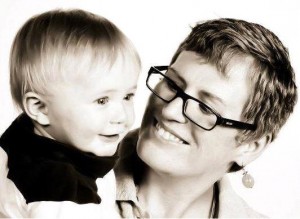Editor’s Note: This weekend we celebrate Mother’s Day with two inspiring stories of Moms whose cancer diagnoses came while they were pregnant. Today, Michelle Maloney shares her story.
On a cold October evening, Michelle Maloney braced herself against the night chill. As she hugged herself in bed, she felt a lump in her right breast. The next morning, Maloney scheduled an appointment with her primary care physician, who asked if she could be pregnant.
“Anything is possible,” said Maloney.Follow-up blood work revealed that the 39-year-old was, in fact, five weeks pregnant with her first child. Unconvinced that the lump was caused by blocked milked ducts – common in pregnant women – her doctor scheduled her for breast imaging. The tests – performed on October 19, Maloney’s wedding anniversary – revealed breast cancer.

Maloney quickly “assembled a team of doctors,” she says. At the helm of her care team was Erica Mayer, MD, MPH, of the Breast Oncology Center at Dana-Farber/Brigham and Women’s Cancer Center (DF/BWCC), who worked closely with maternal-fetal medicine specialist Katherine Economy, MD, of the Department of Obstetrics and Gynecology at Brigham and Women’s Hospital (BWH), over the course of Maloney’s treatment.
“It never occurred to me to go anywhere else,” says Maloney.
Once past the first trimester of pregnancy, Maloney underwent a mastectomy and reconstructive surgery and then began chemotherapy.
“Chemotherapy was scary for me,” she recalls. “To know that these chemicals can kill cancer but won’t hurt your baby – you have to have faith and belief that it’s going to be OK. I had to be calm more than anything else. That is what propelled me through the process.”
“Pregnancy-associated breast cancer is a rare diagnosis, but it is increasing in frequency,” says Mayer. “Over past years of experience and study, treatment plans have been developed that are effective against the cancer and safe for a developing baby. We bring together a multidisciplinary team to care for a woman with pregnancy-associated breast cancer; that team may include medical oncologists, surgical oncologists, radiation oncologists, maternal-fetal medicine specialists, reconstructive surgeons, nurses, and social workers. Our entire team meets with every patient to create a personalized treatment plan, and works together to guide that patient through her treatment and delivery.”
Managing the joy of pregnancy and the challenges of a cancer diagnosis was a “rollercoaster,” says Maloney. While undergoing her first round of chemotherapy, Maloney visited the high-risk pregnancy center at BWH, where she received weekly nonstress tests and ultrasounds to monitor her baby’s health.
After 12 weeks of initial chemotherapy treatment, her team chose to delay the second portion of her chemo until after she had her baby. “This was their gut feeling,” says Maloney. “This made me feel like I was a person, not just a patient in a tumor board review. They considered everything. It wasn’t the same treatment for every person. I felt valued as a patient and as a person. I can’t say enough about the partnership between Dana-Farber and Brigham and Women’s Hospital. They made a plan for me and truly worked together. They were all in sync with the decisions made both for my cancer treatment and my pregnancy. It was fantastic.”
On May 26, 2011, Matthew Maloney was born at 6 pounds 6 ounces. Less than two weeks later, and two days after her first post-pregnancy chemotherapy, Maloney, her husband, and her healthy new baby boy attended Relay for Life. “I was in pain, but I was so excited to be participating, not only as a team member and committee member, but as a survivor for the first time,” she says. “I had a lot to celebrate.”

You and your family deserve every blessing. WTG Dana and Brighams.
What an amazing story about a very courageous young woman and her awesome medical team. It was filled with hope, and very inspirational. Thank you so much.